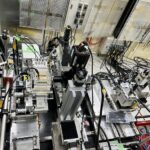
Dormant Cells Hold the Key to Stopping Bone Marrow Cancer Before It Starts
For decades, scientists have grappled with an enigmatic question: why do some individuals harbor early signs of bone marrow cancer yet never develop the full-blown disease? New groundbreaking research led by Assistant Professor Marta Diaz del Castillo from Aarhus University is shedding light on this mystery, revealing that some precursor cells enter a protective state that halts cancer progression. This discovery forces a profound reconsideration of how cancer arises and opens exciting avenues for early intervention and potential prevention.
Multiple myeloma, a malignant cancer of plasma cells within the bone marrow, is invariably preceded by less severe clinical states known as monoclonal gammopathy of undetermined significance (MGUS) and smoldering multiple myeloma (SMM). These precursor states, while not cancerous themselves, pose an elevated risk of progressing to invasive disease—about 1% annually for MGUS and 10% for SMM patients. Yet, intriguingly, many individuals with these precursor conditions remain stable for years, or even a lifetime, without ever developing cancer. Understanding the biological processes that distinguish stable cases from progressing ones has remained a critical challenge.
.adsslot_EZJimNvUzt{width:728px !important;height:90px !important;}
@media(max-width:1199px){ .adsslot_EZJimNvUzt{width:468px !important;height:60px !important;}
}
@media(max-width:767px){ .adsslot_EZJimNvUzt{width:320px !important;height:50px !important;}
}
ADVERTISEMENT
To investigate this, researchers turned to artificial intelligence-enhanced histological analysis, examining bone marrow samples from patients with MGUS and SMM alongside samples from healthy individuals and newly diagnosed myeloma patients. This advanced computational approach enabled the team to identify subtle cellular and microenvironmental changes that herald disease progression—or, importantly, halt it. Their findings were startling: a subset of precursor plasma cells entered a biological state called cellular senescence, a dormant condition in which cells irreversibly cease to divide in response to stress signals without undergoing apoptosis.
Traditionally, senescence has been viewed as a double-edged sword—often implicated in aging and regarded as a potential stepping stone toward malignancy. However, this study is the first to demonstrate that in the context of bone marrow cancer precursors, senescence acts as a critical defense mechanism. Senescent cells create local “hot spots” of dormancy within the bone marrow, effectively forming a barrier that prevents malignant transformation. These dormant cells do not simply halt their own proliferation; they appear to induce senescence in neighboring cells as well, propagating a protective state through paracrine signaling.
Assistant Professor Diaz del Castillo elucidates, “In patients whose disease does not progress, we observe that senescent plasma cells stimulate their surrounding microenvironment to enter dormancy, forming small niches of inactive tissue. This paracrine senescence is likely recognized and managed by the immune system, contributing to tumor suppression.” In contrast, patients whose precursor states evolve into full multiple myeloma lack this widespread dormancy effect, suggesting a failure of the senescence communication pathways or immune surveillance mechanisms.
The implications for clinical practice are profound. Currently, patients diagnosed with MGUS or SMM do not receive therapeutic intervention but are merely monitored for signs of disease progression—a strategy sometimes dubbed “watchful waiting.” The new insights offered by this research point toward possible early treatments that could enhance or mimic senescence pathways, effectively reinforcing the body’s natural cancer defense before malignant cells take hold.
Furthermore, the investigators have identified potential blood biomarkers associated with this protective dormancy state, offering a tantalizing prospect for non-invasive diagnostics. Such biomarkers could enable clinicians to stratify patients according to their risk profiles more accurately and identify those who might benefit from early intervention, circumventing the often devastating consequences once overt cancer develops.
This research also challenges prevailing dogma regarding cellular senescence in oncology. Rather than being solely a negative hallmark or precursor to tumorigenesis, senescence emerges here as a dynamic and context-dependent process with the capacity to restrict cancer development when properly engaged. The study opens exciting questions about how the timing, cellular context, and microenvironmental interactions influence whether senescence acts as a friend or foe.
Ongoing studies aim to unravel the mechanistic underpinnings of the senescence microenvironment crosstalk within the bone marrow niche. The research team is employing advanced molecular profiling methods and mouse models to identify which cells respond to senescent plasma cells and whether manipulating these interactions can alter disease trajectories. Early experimental results also explore whether selective clearance of senescent cells might paradoxically facilitate or impede cancer prevention, underscoring the complexity of senescence biology.
Looking ahead, the interplay between senescence, immune surveillance, and cancer progression may unlock novel therapeutic strategies that harmonize with the body’s intrinsic defense systems. Drugs targeting senescence-inducing pathways or reinforcing immune-mediated clearance of dormant cells might herald a new frontier in hematological cancer prevention, sparing patients from toxic chemotherapies used only after clinical disease manifests.
This paradigm shift, spearheaded by AI-powered tissue analysis and interdisciplinary collaboration across Aarhus University, the Mayo Clinic, and leading pathology centers, exemplifies how cutting-edge technology and fundamental biology can merge to yield transformative clinical insights. The team credits support from major funders including the NIH and the Danish Cancer Society for enabling this high-impact work.
As the global burden of multiple myeloma continues to rise, with often late-stage diagnoses limiting treatment success, these findings provide a hopeful roadmap towards earlier detection and proactive management. Harnessing the protective power of cellular dormancy could one day rewrite the narrative of cancer progression from inevitability to preventability.
In summation, this pioneering study reveals that senescence-induced dormancy within precursor bone marrow cells forms a natural barricade against multiple myeloma. Far from being a mere symptom of aging or cellular decline, senescence here represents an elegant and vital tumor suppressive mechanism. With further research, clinicians may soon be able to identify and amplify this protective state, ushering in an era where bone marrow cancer can be halted before it ever takes root.
Subject of Research: Cells
Article Title: Senescence profiling of monoclonal gammopathies reveals paracrine senescence as a crucial defense against disease progression
News Publication Date: 31-Mar-2025
Image Credits: Aarhus University
Keywords: Senescence, Cell death
Tags: Aarhus University cancer researchartificial intelligence in cancer studiesbiological processes in cancer stabilitybone marrow cancer researchcancer prevention strategiesdormant cancer cellsearly intervention in cancermonoclonal gammopathy of undetermined significancemultiple myeloma progressionprotective state of precursor cellssmoldering multiple myelomaunderstanding cancer progression



